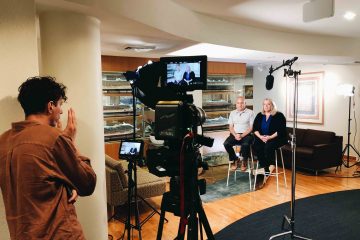Here at Chroma House, our Miami video production crew loves getting in the room with big thinkers. Recently, we had the chance to interview Peter Thiel at Founders Fund’s Wynwood office—a cool spot surrounded by the neighborhood’s colorful murals and creative vibe. Thiel, known for co-founding PayPal and Palantir, shared some thought-provoking ideas about artificial intelligence that got us talking. He sees AI as a game-changer, shaking up industries like never before, and we couldn’t agree more—especially when it comes to video production.
Thiel mentioned in a recent New York Times piece that AI is the real deal, a way to break free from what he calls a “technological stagnation.” He’s excited about its potential to spark progress where things have felt stuck. That perspective hit home for us. As storytellers, we’re seeing AI transform how we create, edit, and share videos, and it’s moving fast. Here’s how it’s reshaping our work at Chroma House and what it means for the industry.
1. Streamlining the Process: Less Grind, More Creativity
Video production can be a slog—planning shots, editing footage, and tweaking details take time. AI is changing that by handling the repetitive stuff. Tools like Adobe’s Sensei or Runway ML can whip up storyboards from text prompts or suggest edits that match the vibe of a scene. In 2025, we’re seeing AI take care of up to 70% of pre-production tasks, like mapping out shoot schedules or even mocking up virtual sets.
In post-production, it’s a similar story. AI-driven color grading in software like DaVinci Resolve fixes footage quickly, and automated captions make videos accessible without hours of manual work. At Chroma House, these tools have cut our editing time significantly, letting us focus on the creative parts—like nailing the story our clients want to tell.
2. Personalized Videos: Content That Feels Made for You
Today’s audiences want content that feels personal, and AI makes that possible on a whole new level. Platforms like Synthesia let us create videos that adapt to viewers—swapping languages or tweaking details to match local tastes, all from one shoot. This is huge for marketing, where a single campaign can now become thousands of tailored versions, each hitting the mark for its audience.
We’re experimenting with this in Miami, It’s efficient and helps our clients connect with their audience in a way that feels one-on-one.
3. Synthetic Media: Real Meets Virtual
AI’s ability to create lifelike visuals is wild. Tools like Sora from OpenAI can generate footage that looks real—think detailed backgrounds or even digital actors—without needing a full crew or expensive sets. This cuts costs dramatically, sometimes by 80%, especially for things like crowd scenes or virtual locations.
Still, there’s a balance. Thiel’s all about pushing boundaries, but we know audiences connect with the human touch—a real smile or an unscripted moment. So at Chroma House, we mix AI-generated elements, like a slick Miami skyline, with real footage to keep things authentic. It’s about using AI to enhance, not replace, the heart of our work.
4. Making Video Production Accessible to All
AI is leveling the playing field. Tools like Frame.io with AI integrations let small teams collaborate seamlessly, while predictive analytics help us spot potential issues early, from budget hiccups to viral potential. This means high-quality video isn’t just for big budgets anymore.
In Miami’s buzzing creative scene, we’re seeing everyone from local artists to startups jump in with pro-level videos. AI’s making it easier for new voices to shine, and that’s something we’re excited to be part of at Chroma House.
Peter Thiel’s take on AI got us thinking about how fast things are moving. We’re embracing these changes—training our team, testing new tools, and keeping the human spark that makes our videos special. Want to see what AI can do for your next project? Reach out to Chroma House, and let’s make something great together.


